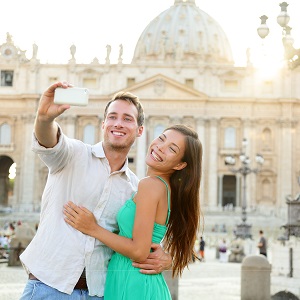As we prepare to offer tours once again to explore the incredible wealth of art held in the Vatican Museums, discover some of the highlights via our virtual tour.
Established in the early 1500s by Pope Julius II, the Vatican Museums house the extensive collection of artworks amassed over centuries by the Catholic Church. With over 20 000 works on display in 54 rooms, you would need a lifetime to fully appreciate all the paintings and sculptures housed in the museum (not to mention the additional 50 000 works in storage). As we get ready to offer our Vatican Tours again in person, you can enjoy a tiny fraction of what is on offer via our virtual tour.
-
Raphael Rooms
The Vatican Museums house an astonishing number of artworks from the Renaissance masters, and one of the most impressive collections is the series of frescoes by Raphael known collectively as the Raphael Rooms (Stanze di Raffaello). The decoration of these rooms, which at the time were the papal apartments, was commissioned by Pope Julius II in 1508. Following Raphael’s death in 1520, the final room, the Sala di Costantino, was completed by his studio.
The first room to be finished, the Stanza della Segnatura, contains one of Raphael’s best-known works, the School of Athens (Scuola di Atene). The frescoes on each wall represent the four branches of human knowledge: philosophy, theology, poetry and jurisprudence. The School of Athens, depicting several important Ancient Greek thinkers, is the representation of philosophy.
The two central figures in the painting are Plato, the older man in red, and Aristotle, the younger man on the right. The men are identified not only by the books they are holding, as each is holding a copy of their own book, but also by the symbolism Raphael used to portray them. Plato is pointing upwards to the sky and is dressed in purple and red, colours representing fire and air, signifying his interest in ethereal subject matters, while Aristotle is dressed in colours representing earth and water and signally downwards with his outstretched arm, representing his interest in more observable subjects.
Raphael worked on the School of Athens at the same time Michelangelo was painting the Sistine Chapel, and his influence can be observed in the form of several of the figures. Michelangelo himself was used as model in the figure of Heraclitus, while other prominent artists also make an appearance including Leonardo Da Vinci as Plato and Bramante as Euclid. Raphael is included in the group surrounding Euclid, staring directly at the observer. It’s an incredible work that characterises the High Renaissance.
-
Gallery of Maps
Before you enter the Sistine Chapel, you will pass through a long corridor known as the Gallery of Maps. Displayed along 120 metres of wall are 40 maps, commissioned by Pope Gregory XIII and produced by Ignazio Danti from 1500 – 1503. The amazing works depict the Italian regions and notable cities, with the Tyrrhenian coast displayed on the left and Adriatic on the right as you walk towards the Sistine Chapel. Also included are two full maps of the Italian peninsula, one depicting Ancient Italy and the other Modern Italy in 1500, and the four major ports of Venice, Ancona, Genoa and Civitavecchia.
Despite their age, having been painted over 500 years ago without the assistance of the modern technology we use today, the maps are remarkably accurate. In 2011, the maps were restored at a cost of more than €2 million. While wandering through the room, don’t forget to look up at the ornate ceiling, decorated with paintings by artists including Girolamo Muziano and Cesare Nebbia.
-
Sistine Chapel
Continuing through the museums, we arrive at the Sistine Chapel, the private chapel of the pope and home to some of the Western World’s most accomplished frescoes. The two side walls are decorated by paintings by famous Renaissance artists including Sandro Botticelli, Perugino and Domenico Ghirlandaio. The six frescoes of the north wall depict scenes from the life of Christ, while the six on the south depict the life of Moses. For the decoration of the lower half of the wall, Raphael designed tapestries illustrating stories from the lives of St Paul and St Peter to be hung on special occasions.
However, these accomplished and impressive artworks are overshadowed by the works of Michelangelo that adorn the ceiling and west wall. The ceiling frescoes depict nine scenes from the Old Testament, including the most famous painting, The Creation of Adam. Commissioned by Pope Julius II, Michelangelo reluctantly accepted the request to redecorate the Sistine Chapel ceiling in 1508, considering himself a sculptor not a painter. Despite Michelangelo’s lack of enthusiasm for the work, the ceiling is considered an essential work of the High Renaissance and his work on the human figure continues to be hugely influential.
The wall behind the alter was commissioned later by Pope Clement VII in 1534 and illustrates the separation of the blessed and the damned in the Last Judgement. In the painting containing an astonishing 300 figures, the dead are awoken to rise to heaven or descend to hell as judged by Christ depicted in the top centre. While Michelangelo originally painted nearly all the figures nude, this was not well received by the church, who instructed another artist to cover the nudes by painting drapery over them.
Related article: Bernini and the Vatican
Explore Our Vatican Tours!
-
Rome Day Tour with Vatican & Colosseum
9 Hours
€95
See More -
Morning Vatican & Sistine Chapel Tour
3 Hours
€85
See More -
Extended Vatican Museums & Gardens Tour
5 Hours
€99
See More -
Vatican & Sistine Chapel Night Tour
2 Hours
€59
See More





